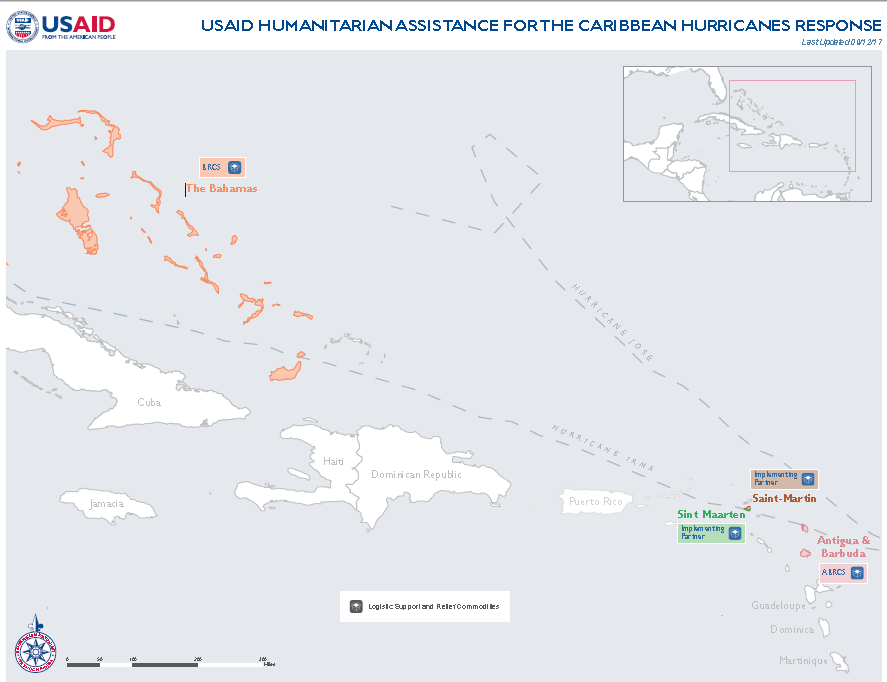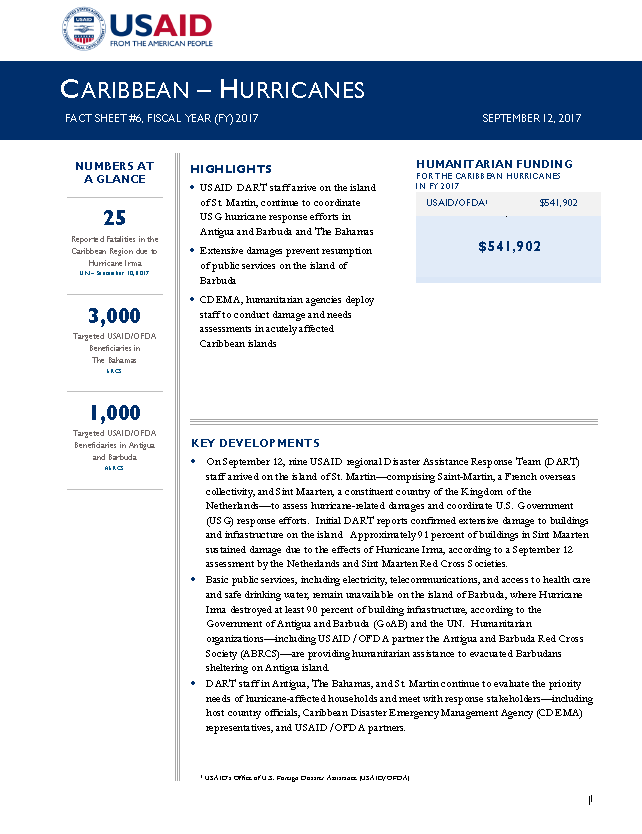Speeches Shim
September 12, 2017
Highlights
- USAID DART staff arrive on the island of St. Martin, continue to coordinate USG hurricane response efforts in Antigua and Barbuda and The Bahamas.
- Extensive damages prevent resumption of public services on the island of Barbuda.
- CDEMA, humanitarian agencies deploy staff to conduct damage and needs assessments in acutely affected Caribbean islands.
Key Developments
On September 12, nine USAID regional Disaster Assistance Response Team (DART) staff arrived on the island of St. Martin—comprising Saint-Martin, a French overseas collectivity, and Sint Maarten, a constituent country of the Kingdom of the Netherlands—to assess hurricane-related damages and coordinate U.S. Government (USG) response efforts. Initial DART reports confirmed extensive damage to buildings and infrastructure on the island. Approximately 91 percent of buildings in Sint Maarten sustained damage due to the effects of Hurricane Irma, according to a September 12 assessment by the Netherlands and Sint Maarten Red Cross Societies.
Basic public services, including electricity, telecommunications, and access to health care and safe drinking water, remain unavailable on the island of Barbuda, where Hurricane Irma destroyed at least 90 percent of building infrastructure, according to the Government of Antigua and Barbuda (GoAB) and the UN. Humanitarian organizations—including USAID/OFDA partner the Antigua and Barbuda Red Cross Society (ABRCS)—are providing humanitarian assistance to evacuated Barbudans sheltering on Antigua island.
DART staff in Antigua, The Bahamas, and St. Martin continue to evaluate the priority needs of hurricane-affected households and meet with response stakeholders—including host country officials, Caribbean Disaster Emergency Management Agency (CDEMA) representatives, and USAID/OFDA partners.
Caribbean Hurricanes - Map #6 ![]() (pdf - 297k)
(pdf - 297k)
Numbers At A Glance
25
3,000
1,000
Humanitarian Funding
For the Caribbean Hurricanes in FY 2017
| USAID/OFDA | $541,902 |
Caribbean Hurricanes - Fact Sheet #6 ![]() (pdf - 188k)
(pdf - 188k)
REGIONAL
CDEMA, in coordination with UN agencies, host country governments, and other relief stakeholders, continues to manage regional hurricane response efforts from its headquarters in Barbados. As of September 12, CDEMA had deployed disaster coordination and rapid needs assessment teams—including members of the Caribbean Community (CARICOM) Disaster Relief Unit, comprising firefighters, military, and police officers from CDEMA’s 18 member states—to Anguilla, Antigua and Barbuda, and the British Virgin Islands to conduct damage and needs assessments, in coordination with UN Disaster Assessment and Coordination (UNDAC) teams and other response actors.
UN agencies and international organizations—including the International Organization for Migration and the Pan American Health Organization—have deployed staff with expertise in displacement tracking; health; shelter; and water, sanitation, and hygiene (WASH) to conduct assessments and support relief activities in acutely hurricane-affected islands. Additionally, the UN Children’s Fund (UNICEF) is providing an initial shipment of life-saving relief supplies—valued at approximately $250,000—for the response.
The UN World Food Program (WFP) plans to establish two sub-regional hubs to manage its emergency food response in the Caribbean region, including a hub in Antigua to support the eastern Caribbean and a hub in Turks and Caicos Islands (TCI) to support The Bahamas and TCI. WFP has launched two immediate response emergency operations requesting an estimated $1.9 million to provide emergency food assistance in the region, including approximately $1.5 million for cash transfers for food and High-Energy Biscuits (HEBs) to assist hurricane-affected people in the eastern Caribbean and $400,000 for HEBs to assist hurricane-affected people in the western Caribbean.
ANTIGUA AND BARBUDA
On September 11, members of the USAID regional DART met with the GoAB National Office of Disaster Services (NODS) to discuss the response to Hurricane Irma. Basic public services, including electricity, telecommunications, and access to health care and safe drinking water, remain unavailable on Barbuda, where Hurricane Irma destroyed at least 90 percent of building infrastructure, according to the GoAB and the UN. To date, the GoAB has recorded more than 1,400 Barbudan evacuees who are temporarily sheltering on the island of Antigua; NODS volunteers continue to register Barbudan evacuees seeking shelter at informal sites.
To address the protection needs of evacuated populations, UNICEF is deploying staff from non-affected islands in the Caribbean region to provide psychosocial support for hurricane-affected children, including Barbudan evacuees sheltering in Antigua. As of September 10, UNICEF had identified up to 100 unaccompanied children who evacuated from Barbuda to Antigua and are receiving care-giving services through the GoAB Ministry of Social Transformation and Human Resource Development. Additionally, in coordination with the GoAB Directorate of Gender Affairs, the UN Population Fund (UNFPA) has distributed approximately 320 dignity kits—containing basic health and hygiene products—to women and girls evacuated from Barbuda.
DART staff in Antigua continue to meet with response stakeholders—including USAID/OFDA partner ABRCS—to evaluate the priority needs of hurricane-affected households and coordinate response efforts. To date, USAID/OFDA has provided $100,000 to ABRCS to assist approximately 1,000 hurricane-affected people in Antigua and Barbuda.
THE BAHAMAS
According to Government of the Commonwealth of The Bahamas (GoCB) officials, the most populated areas in The Bahamas, such as Grand Bahama and New Providence islands, experienced minimal impacts from Hurricane Irma’s passage. On September 11, Bahamian utility agencies noted that the restoration of electrical, water, and other basic services on Grand Bahama is likely to occur by the end of the week, local media report.
Hurricane Irma resulted in more significant—but less than anticipated—damages on The Bahamas’ southern islands, such as Acklins, Crooked Island, Inagua, and Mayguana, islands, as well as the Bimini Islands in the northwest, according to the GoCB. On September 12, the GoCB declared Ragged Island uninhabitable, following damage assessments conducted by GoCB officials, including Prime Minister Dr. Hubert Minnis and National Emergency Management Agency (NEMA) staff. Following the visit, Prime Minister Minnis announced plans to transport the island’s remaining inhabitants—approximately 20 people—to New Providence Island by September 13, local media report. GoCB damage assessments of other affected areas remained ongoing as of September 12.
Two USAID/OFDA staff arrived in Nassau, The Bahamas, on September 11. The team is meeting with staff at NEMA and at the U.S. Embassy in Nassau to discuss response efforts and to prepare for planned airlifts of USAID/OFDA commodities due to arrive in The Bahamas in the coming days. In addition, USAID/OFDA is supporting the Bahamas Red Cross Society (BRCS) to provide emergency relief items to approximately 3,000 hurricane-affected Bahamians.
ST. MARTIN
On September 12, nine USAID regional DART staff arrived on the island of St. Martin—comprising Saint-Martin, a French overseas collectivity, and Sint Maarten, a constituent country of the Kingdom of the Netherlands—to evaluate hurricane-related damages and coordinate USG response efforts. Initial DART reports confirmed extensive damage to buildings and infrastructure on the island. Approximately 91 percent of buildings in Sint Maarten sustained damage due to the effects of Hurricane Irma, according to a September 12 assessment by the Netherlands and Sint Maarten Red Cross Societies.
In coordination with the Government of France (GoF), the Government of the Kingdom of the Netherlands (GoKN), and the U.S. Department of Defense (DoD), USAID/OFDA is working to provide critical humanitarian assistance to hurricane-affected populations. To date, USAID/OFDA has provided a combined $200,000 to address urgent humanitarian needs on the island.
OTHER USG RESPONSE
The U.S. Department of Defense is supporting USAID/OFDA efforts to provide emergency assistance through the transport of humanitarian personnel, relief supplies, and other critical logistics support in French Saint-Martin, Sint Maarten, and other hurricane-affected islands.
The USAID DART and RMT continue to coordinate with government officials, CDEMA, and other stakeholders throughout the Caribbean to evaluate and respond to hurricane-related needs.
INTERNATIONAL RESPONSE
Hurricane Irma caused significant damage in northern Cuba when it made landfall as a Category 5 hurricane on September 9, resulting in at least 10 deaths and displacing more than 1.1 million people, according to the UN and the Government of Cuba (GoC). The GoC is leading the response, with support from UN agencies and other relief actors.
On September 11, the European Commission’s Directorate-General for Humanitarian Aid and Civil Protection (ECHO) announced €2 million—approximately $2.4 million—in assistance for the Caribbean region to provide health, logistics, and WASH support on acutely hurricane-affected islands. The additional funding brings total ECHO support for the hurricanes response to nearly €2.2 million, or approximately $2.6 million.
OTHER USG RESPONSE
DoD is supporting USAID/OFDA efforts to provide emergency assistance through the transport of humanitarian personnel, relief supplies, and other critical logistics support in French Saint-Martin, Sint Maarten, and other hurricane-affected islands.
The USAID DART and RMT continue to coordinate with government officials, CDEMA, and other stakeholders throughout the Caribbean to evaluate and respond to hurricane-related needs.
INTERNATIONAL RESPONSE
On September 11, the Government of the Kingdom of Belgium announced €1 million, or approximately $1.2 million, in humanitarian assistance for the hurricane-affected Caribbean islands. In addition, a member of the Belgian First Aid and Support Team, initially deployed to the UNDAC coordination center in Haiti, is scheduled to travel to Sint Maarten imminently to support Dutch humanitarian response operations
CONTEXT
Hurricane Irma—the strongest Atlantic hurricane on record—began affecting the eastern Caribbean in early September. On September 6, the hurricane made landfall over the island of Barbuda in the northeastern Caribbean before passing near The Bahamas, the Dominican Republic, and Haiti and making secondary landfall in Cuba on September 9. The hurricane brought destructive winds, heavy rainfall, and dangerous storm surge, resulting in at least 25 fatalities and causing significant infrastructure damage across the Caribbean region.
Between September 9 and 10, Hurricane Jose passed approximately 75 miles northwest of the island of St. Martin, causing less damage than anticipated in the Caribbean region. Damage and needs assessments following the passage of Hurricanes Irma and Jose remain ongoing.
On September 6, U.S. Chargé d’Affaires, a.i., Lisa A. Johnson issued a disaster declaration in response to the anticipated effects of Hurricane Irma in The Bahamas, and on September 7, U.S. Ambassador to Barbados and the Eastern Caribbean Linda S. Taglialatela issued a disaster declaration in response to Hurricane Irma and the anticipated effects of Hurricane Jose in Antigua and Barbuda. In response, USAID/OFDA is contributing an initial $100,000 each to the BRCS and the ABRCS.
On September 7, USAID activated a regional DART with staff in The Bahamas, Barbados, the Dominican Republic, and Haiti. USAID also stood up a Washington, D.C.-based RMT to coordinate the USG’s humanitarian response to the hurricanes.
On September 9, U.S. Embassy in Paris Chargé d’Affaires D. Brent Hardt issued a disaster declaration for the French Saint-Martin, and on September 10, U.S. Embassy in The Hague Chargé d’Affaires Shawn Crowley issued a disaster declaration for Sint Maarten due to the effects of Hurricane Irma and anticipated effects of Hurricane Jose. In response, USAID/OFDA contributed an initial $100,000 each for response activities in Saint-Martin and Sint Maarten.
PUBLIC DONATION INFORMATION
The most effective way people can assist relief efforts is by making cash contributions to humanitarian organizations that are conducting relief operations. A list of humanitarian organizations that are accepting cash donations for disaster responses around the world can be found at www.interaction.org.
USAID encourages cash donations because they allow aid professionals to procure the exact items needed (often in the affected region); reduce the burden on scarce resources (such as transportation routes, staff time, and warehouse space); can be transferred very quickly and without transportation costs; support the economy of the disaster-stricken region; and ensure culturally, dietary, and environmentally appropriate assistance.
More information can be found at: USAID Center for International Disaster Information: www.cidi.org or +1.202.661.7710. Information on relief activities of the humanitarian community can be found at www.reliefweb.int.



Comment
Make a general inquiry or suggest an improvement.